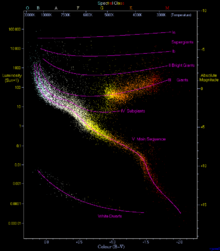HD 154088
| Observation data Epoch J2000.0 Equinox J2000.0 | |
|---|---|
| Constellation | Ophiuchus |
| Right ascension | 17h 04m 27.84s ± 5.62[1] |
| Declination | −28° 34′ 57.64″ ± 3.16[1] |
| Apparent magnitude (V) | 6.7258 ± 0.005[1] |
| Characteristics | |
| Spectral type | K0V |
| B−V color index | 0.814 ± 0.034[1] |
| Astrometry | |
| Radial velocity (Rv) | 14.2972 ± 0.0003[2] km/s |
| Proper motion (μ) | RA: 83.76 ± 0.64[1] mas/yr Dec.: -268.69 ± 0.36[1] mas/yr |
| Parallax (π) | 56.06 ± 0.50[1] mas |
| Distance | 58.2 ± 0.5 ly (17.8 ± 0.2 pc) |
| Absolute magnitude (MV) | 5.47 ± 0.02 |
| Details | |
| Mass | 0.97 ± 0.05[3] M☉ |
| Radius | 0.95 ± 0.03[4] R☉ |
| Luminosity | 0.68 +0.06 −0.05 (log -0.169 ± 0.033)[5] L☉ |
| Surface gravity (log g) | 4.40 ± 0.11[3] cgs |
| Temperature | 5423 ± 51[3] K |
| Metallicity [Fe/H] | 0.31 ± 0.03[3] dex |
| Rotation | 42.6 ± 4.4[6] |
| Rotational velocity (v sin i) | 1.9 ± 0.5[5] km/s |
| Age | 3 - 8[3] Gyr |
| Other designations | |
| Database references | |
| SIMBAD | data |
| Extrasolar Planets Encyclopaedia | data |
HD 154088 is a seventh magnitude metal-rich K-type main sequence star that lies approximately 58 light-years away in the constellation of Ophiuchus. The star is orbited by a hot Super-Earth.
Properties[]

HD 154088 is a modestly bright star that lies at the bottom of Ophiuchus, near to the border with Scorpius and near to the plane of the Milky Way. The star was recognised as a high proper motion star during the last century, and early Earth-based parallax measurements such as that of the Gliese Catalogue of Nearby Stars indicated a distance of about 50 light-years.
The star has a spectral type of K0V, indicating that it is a main sequence star that is about 350 degrees cooler than the Sun. On the Hertzsprung-Russell diagram (left), the star lies slightly above the main sequence. This is because the star is very metal-rich; with an Fe/H of 0.3 dex the star has about twice the solar abundance of iron, which makes HD 154088 fall into the somewhat vague group of super metal-rich (SMR) stars. The giant planet occurrence rate of Fe/H = 0.3 stars is on the order of 30%, but HD 154088 is not currently known to host any giant planets.
HD 154088 has a pronounced magnetic field.[3] It also has a magnetic cycle similar to the Sun,[6] though its length is not well constrained.
The survey in 2015 have ruled out the existence of any additional stellar companions at projected distances from 8 to 119 astronomical units.[7]
Planetary system[]
A planet orbiting HD 154088 discovered with the HARPS spectrograph was announced in September 2011. With a minimum mass of 6 Earth masses, the companion falls into the regime of Super-Earths.
| Companion (in order from star) |
Mass | Semimajor axis (AU) |
Orbital period (days) |
Eccentricity | Inclination | Radius |
|---|---|---|---|---|---|---|
| b | ≥6.15 ± 0.86 M |